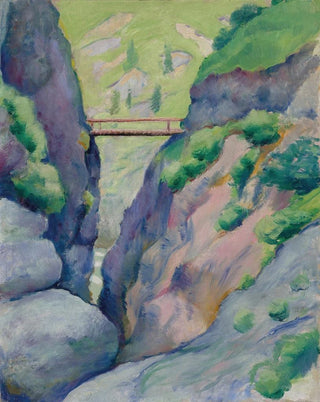Art print | Gorges of Tegernsee - August Macke


View from behind

Frame (optional)
Art print Gorges du Tegernsee - August Macke – Engaging Introduction
In the vast panorama of art history, certain works stand out for their ability to capture the essence of a moment and a place. "Gorges du Tegernsee - August Macke" is one such creation that, through its beauty and depth, invites a complete immersion in a landscape imbued with serenity. Macke, one of the emblematic figures of the Expressionist movement, manages to transcend mere representation to offer a poetic and vibrant vision of nature. Through this piece, the viewer is transported into a universe where light and color intertwine to bring to life an enchanting panorama, evoking both inner peace and wonder at the magnificence of the world.
Style and uniqueness of the work
The artwork "Gorges du Tegernsee" is distinguished by its bold use of color and form. Macke, faithful to his expressionist style, favors vivid hues and striking contrasts, thus creating an atmosphere that is both dynamic and soothing. The forms, although stylized, retain a certain fluidity that evokes the movement of water and the breath of the wind through the trees. The composition of the piece, with its winding lines and daring perspectives, guides the viewer’s gaze toward the horizon, inviting exploration of the depths of the landscape. This unique approach demonstrates Macke’s ability to transform a simple landscape into a sensory experience, where each color and shape seems to vibrate with its own life.
The artist and his influence
August Macke, born in 1887, is often regarded as one of the pioneers of German Expressionism. His career, though tragically cut short by his premature death in 1914, profoundly impacted the art world. Influenced by movements such as Fauvism and Cubism, Macke developed a style that is uniquely his own, combining a sensitivity to color with a deep understanding of human emotions. Through his works, he seeks to express not only the beauty of the natural world but also the feelings and perceptions that accompany it. His influence endures today, inspiring

Matte finish

View from behind

Frame (optional)
Art print Gorges du Tegernsee - August Macke – Engaging Introduction
In the vast panorama of art history, certain works stand out for their ability to capture the essence of a moment and a place. "Gorges du Tegernsee - August Macke" is one such creation that, through its beauty and depth, invites a complete immersion in a landscape imbued with serenity. Macke, one of the emblematic figures of the Expressionist movement, manages to transcend mere representation to offer a poetic and vibrant vision of nature. Through this piece, the viewer is transported into a universe where light and color intertwine to bring to life an enchanting panorama, evoking both inner peace and wonder at the magnificence of the world.
Style and uniqueness of the work
The artwork "Gorges du Tegernsee" is distinguished by its bold use of color and form. Macke, faithful to his expressionist style, favors vivid hues and striking contrasts, thus creating an atmosphere that is both dynamic and soothing. The forms, although stylized, retain a certain fluidity that evokes the movement of water and the breath of the wind through the trees. The composition of the piece, with its winding lines and daring perspectives, guides the viewer’s gaze toward the horizon, inviting exploration of the depths of the landscape. This unique approach demonstrates Macke’s ability to transform a simple landscape into a sensory experience, where each color and shape seems to vibrate with its own life.
The artist and his influence
August Macke, born in 1887, is often regarded as one of the pioneers of German Expressionism. His career, though tragically cut short by his premature death in 1914, profoundly impacted the art world. Influenced by movements such as Fauvism and Cubism, Macke developed a style that is uniquely his own, combining a sensitivity to color with a deep understanding of human emotions. Through his works, he seeks to express not only the beauty of the natural world but also the feelings and perceptions that accompany it. His influence endures today, inspiring






